See bottom of page for our new Lycoris.
Fall Stars
Think of Fall Bulbs, and most of us think of Daffodils and Tulips, Hyacinths and Crocuses. I'd like to talk about some of the less-mentioned bulbs, most of them quite short.
Why are they stars? Well, maybe it would be more accurate to call them “Supporting Stars” – those that complement and make the Daffodils and Tulips shine. You might also call them “Understory” or “Underplanted” Blubs” as they can fill in bare areas between the real stars and give you texture and contrast. They can be planted almost like a ground cover in front and among the taller Daffodils and Tulips. For example, masses of blue Muscari (Grape Hyacinths) planted in front of and among taller yellow Daffodils make a striking display.
Here are a few bulbs you might consider:
Chionodoxas self-seed freely under trees or shrubs and are one of the earliest bulbs to bloom in the Spring, when a bit of color is so welcome. Their common name is Glory of the Snow as they often bloom in late winter when there is still snow on the ground. They are excellent for rock gardens, in the front of raised beds or they can be forced indoors. They are also excellent naturalizers. Forbesii have 6 to 10 star-shaped lilac blue flowers with a white center on slender stems. They also come in pink and white with yellow centers and will easily spread by self-seeding if you don’t deadhead.
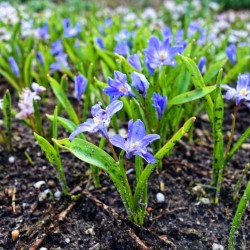
Another star for the southern garden (or lovely in pots farther north) are the Cyclamen. These Cyclamen are a hardy relative of the popular florist's Cyclamen. They are excellent for the rock garden, under trees or in the border. Cyclamen do very well as a pot plant (1 in a 4" pot or 3 in a 10" pot), but leaving them undisturbed in the garden will result in an excellent groundcover.
Our Hederifolium Cyclamen blooms in late summer to winter and have pale pink-violet flowers with swept back petals – some call them “Butterfly flowers”. Their heart-shaped leaves of green, marbled with white, remain long after the flowers bloom out making a nice groundcover. They grow well in the shade and naturalize well. Coum Cyclamen have white, pink, magenta or red flowers blotched with purple. The hardiest of the Cyclamen, they're small plants, usually not more than 2-3 inches tall, with flat, heart-shaped leaves that go can be dark green to dark red, but are usually a mosaic of green patterns. Coum provides color in the garden in late fall and winter, appearing in December-March. These little beauties prefer dry shade - good drainage is paramount. They will self-seed.
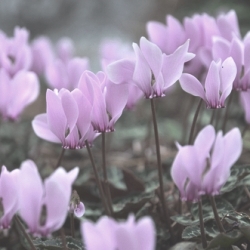 |
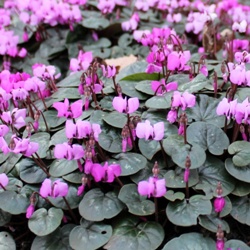 |
| Hederifolium |
Coum |
Eranthis Cilicia (Winter Aconite) are one of the earliest blooms in early Spring - early than the Crocuses even. They have sweet cup-shaped bright yellow blooms, similar to buttercups that sit atop glossy green leaves and last for weeks. They often send their shoots up through the snow. Winter Aconite -- a true harbinger of Spring. Eranthis Cilicica feature golden yellow buttercup-like bowls of petals that sit just a few inches above the ground. Every year, early spring, they come up with their cheerful, bright yellow flowers.
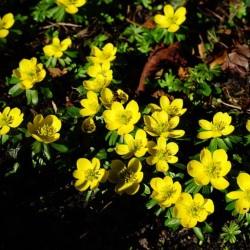
Galanthus Nivalis bloom in February/March and grow in northern climes – zones 3 to 6. They are known as Snowdrops since they often pop up through the snow and come in both single and double forms. They are ideal for planting in rock gardens and will easily naturalize. Live in the South? Leucojums are known as the “Southern Snowdrop” or “Snowflake” and grow from Zones 5 through 9. They are related to Galanthus, but mature later in the Spring. Both have tiny white droopy flowers with green markings on the edges. Leucojums have more of a bell shaped flower while Galanthus blooms look like a bell that has opened up.
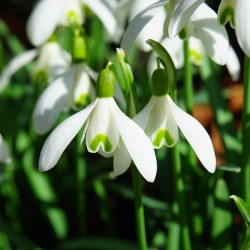 |
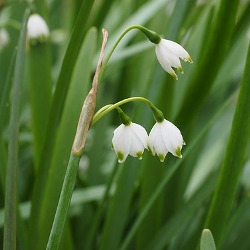 |
| Galanthus |
Leucojum |
Ipheion is an under-appreciated little flower, primarily planted in the South (zones 6-9). Ipheon Unifolium ('Spring Starflower') are sweetly-scented pale blue star-shaped flowers and grass-like foliage that smells like garlic when crushed. They are great for planting in a rock garden, for pots, borders or for underplanting with Peonies or Hostas. Although they may start slowly the first year, they naturalize very well in areas with good drainage, and, once established, produce masses of quarter size flowers lasting up to four weeks in the garden.
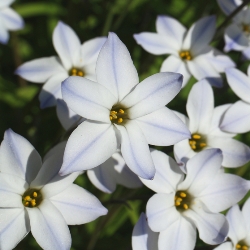
These dainty irises are well known dwarfs that grow 4-5" high and bloom in February or March and in some gardens as early as January. They come in lovely shades of blue, purple, violet and yellow. The standards are usually a lighter color, sometimes with a yellow or orange stripe down the center. They like well-drained but moisture holding soil. If they are too dry they may split into bulbils and not flower for a couple of years. Deep planting is said to help keep them from dividing too much. Plant in full sun in the Fall - they will often bloom before the snow melts in the Spring. You can also force them in a pot indoors. They're also known as "Rock Garden Iris" because they are small and so doggone cute!
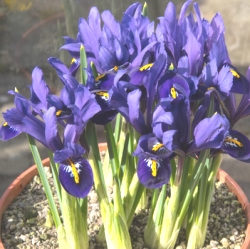
Muscari, or Grape Hyacinths, are no-care bulbs that are a must have in every garden or landscape. They are deer resistant, naturalize well, make a good cut flower and are easy to grow in well-drained soil in full sun to partial shade. Blue is the most common color, particularly armeniacum, although several other colors and bi-colors are available. Their height rarely exceeds 12 inches. I use these as a “marker” plant, tucking one in on top of newly planted bulbs. The stem is leafless but one or two fleshy long linear leaves grow from the base and appear before the flowers -- often in Fall, - so you can see where not to dig the following year. The flowers appear in early Spring and continue to grow, withering into dormancy for 2 or 3 months in the Summer.
Muscari are not as glamorous as the showier bulbs but they are nonetheless popular for filling gaps in the border and as a companion to Tulips and Daffodils. With their bright blue color, they can provide a beautiful contrast to yellow Daffodils like King Alfred, to brilliant red Tulips or underplanted bellow azaleas and dogwoods.
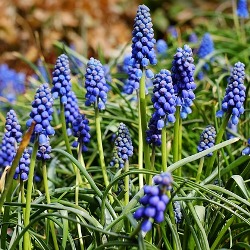
Closely related to Scilla and Chionodoxa, Puschkinia, or Striped Squill, are excellent for planting in a rock garden, in between shrubs or in pots. Puschkinia have spikes of 4-10 open pale blue flowers, with blue stripes on the mid-veins. The small (1/2”) attractive starry flowers appear early in the year from late winter to early spring, and the bulbs increase to form large clumps. They can be forced, naturalize easily, self-seed or produce bulbils and are completely hardy and trouble-free. These do best in northern climates as they grow well where the ground freezes and look best naturalized in clumps and drifts; however, be sure to mulch in the fall. These are small plants, so plant in groups for a more dramatic effect. As a bonus, Squirrels don’t like them!
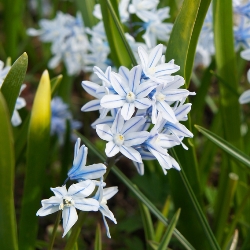 |
NEW!!
This year we are carrying a new Lycoris called Sprengeri Lycoris. Also called Electric Blue Lycoris, they have large pink, trumpet-shaped flowers with slightly reflexed petals and blue streaking at their tips. The color can vary from pink tipped with blue to a deeper pink to more blue, changing as they mature.
Like the Squamigera Lycoris, the foliage will disappear in July, with flowers appearing in late summer to early fall on naked stems. Plant in full sun in organically rich soil that dries out in summer for best results. Be sure to mulch in fall. Please note, it is common for Lycoris to take a year or more after transplanting before blooming.
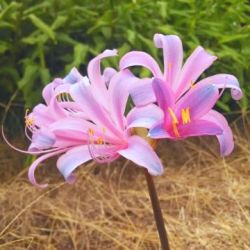
10% PRESEASON DISCOUNT ON FALL BULBS ONLY. ON THE CHECKOUT PAGE AT #5 ENTER the discount code: fall2019. $30 MINIMUM PURCHASE. ENDS SEPTEMBER 12.
Happy gardening!
Blessings,
Mary
www.marysgardenpatch.com |
|
